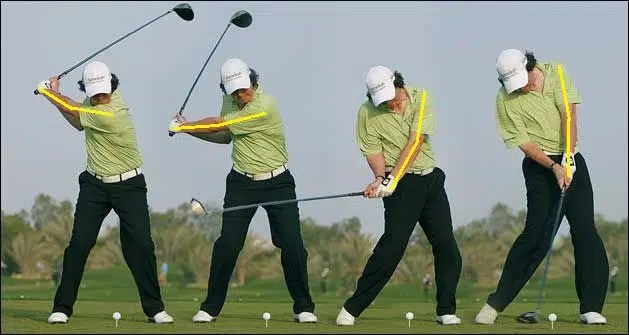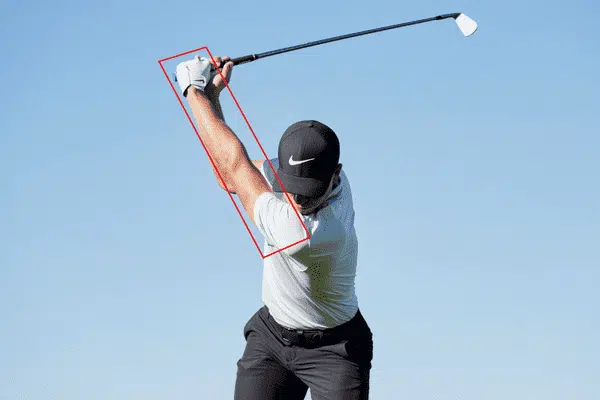As amateur golfers, one of the most common pieces of advice you’ll likely receive from other players – especially when you’re new to the game – is that in order to make a good swing, you must keep your lead arm straight at all costs.
So, for right-handed players that means keeping your left arm straight, and for left-handed players that means keeping your right-arm straight (for the purpose of this article, I’ll be referencing right-handed players to avoid any confusion).
As is often the case when you try something new in golf, particularly if you’re a beginner, is to exaggerate every piece of advice you’re given.
When I was first told to keep my left arm straight during the entire swing – from address, to the top of the backswing, into the downswing and finally through impact – I tried to eliminate every bit of bend possible by keeping my elbow completely locked from start to finish.
Only years later did I find out that doing this is far more likely to hinder my golf swing than help it. So, what is the correct way to do it?
Golfers should try and keep their left arm as straight as possible without it being rigid, or locked, but some bend is fine. Most professional players start with a straight left arm at address, which bends to around five degrees at top of their backswing. Their left arm continues to flex slightly in the downswing and will have around eight degrees of bend at impact.
Keep reading to see what some of the world’s top golf instructors have to say about keeping your left arm straight in the golf swing versus what the actual data says.
Table of contents
How important is keeping a straight left arm in golf?
The reason players are encouraged to keep their left arm straight through their golf swing is to create as much width as possible during the takeaway and backswing.
You should try and make the biggest arc possible with your club, as this will generate the most speed and consistency in your golf swing.
But, as you’ll see below, most golf instructors are fine with players bending their left arm to some degree – but only if done in conjunction with an adequate hip and shoulder turn.
Without this, players with a bent left arm will tend to pick the club up with their arms, without rotating their body as well, which will lead to inconsistent and less powerful ball striking.

What golf instructors say about keeping a straight left arm
There is so much advice online about maintaining a straight left arm throughout your golf swing, with the general consensus being that some bend is fine as long as it is combined with the right amount of shoulder and hip turn.
Here’s how some of the world’s most recognised golf instructors view the importance of keeping the left arm straight during the swing.
Piers Ward from Me And My Golf:
It (your left arm) is allowed to bend. It shouldn’t be ram-rod straight unless you have ultimate, super flexibility. But if there’s a little bit of bend in it, then it’s generally OK. So we always like the phrase ‘comfortably straight’; so not ‘it’s hurting, I can’t do it’, but comfortably straight.
Shaun Webb from Athletic Motion Golf:
At address, we see a lot of golfers with a completely locked-out left arm, or locked joint. In no other sport do you want to lock your joints, we want to see freedom of movement. The arms and shoulders need to be relaxed to get the club going fast. But at address, if you lock up your lead arm then your body gets really tight … and can lead to some really poor (backswing) and downswing motions.
Matt Fryer from Matt Fryer Golf:
If we don’t (keep the arm straight) it actually acts as another lever, if you bend your arm. The only problem would be, if you’re trying to bend your arm and restraighten it on the way down, what we might see is casting of the club. And at the speed you’re moving the club around your body, to try and bend something and restraighten it at the right time is going to be quite hard to manage. So, if we keep it straighter, it will be a lot easier for you to manage.
Clay Ballard from Top Speed Golf:
The main thing that we want to guard against if we’re bending our arm a little bit in the backswing, is we want to make sure we’re rotating our chest. Some players are going to bend their arm a little bit at the top of the swing, but they’re still going to make that good chest and shoulder rotation, and that’s completely fine. We just need to guard against picking (the club) up with the arms, and not rotating the chest. The main goal is getting that big turn with your core, and that’s going to allow you to get that great swing speed whether the arm is a little bit bent or not.
Rick Shiels from Rick Shiels Golf:
It doesn’t have to be perfectly straight, it’s not absolutely crucial. The more we can keep it straight, the better but there’s many golfers out there who keep it as straight as they can (but still have it a little bent at the top). The one bit that is crucial is coming back down and getting through impact. So, let’s say you get at the top of your swing and there’s a little bit of a kink in your left arm, if you can come back down and eradicate that kink, and keep it nice and straight when you make contact, great, because it’s going to help you improve the consistency of your strike.
What biomechanical data says about keeping a straight left arm
So, while the majority of golf instructors prefer players to keep their arm as straight as possible during their swing – allowing for slight bend as you approach the top of your backswing – how does this actually compare to the world’s best players?
Athletic Motion Golf is an extremely informative YouTube channel that uses computer-driven biomechanics data to show the differences between how a professional golfer moves during the golf swing versus how an amateur player moves during the golf swing.
These were the results when they analysed the left-arm straightness of a professional versus an amateur as it moved from address through to impact:
PGA Tour player:
- Left elbow -3.6 degrees (hyper flexed) bent at address
- Left elbow 0.0 degrees bent at first parallel in backswing
- Left elbow 5.5 degrees bent at top of backswing
- Left elbow 6 degrees bent at second parallel in downswing
- Left elbow 8 degrees bent at impact
Amateur player:
- Left elbow 3.6 degrees bent at address
- Left elbow 3.9 degrees bent at first parallel in backswing
- Left elbow 8.7 degrees bent at top of backswing
- Left elbow -1.5 degrees bent at second parallel in downswing
- Left elbow -1.3 degrees bent at impact
What this data shows is that professional players actually slightly bend their left arm as it moves from the top of the backswing, into the downswing and through impact (creating more speed and control) and only straighten it after the ball has been struck, whereas an amateur player does the opposite.
For an amateur, this movement can create three key problems in their swing.
1. Out of sync inside takeaway
Complete locking of the left arm causes many players to turn their whole body and shoulders too far inside the swing plane. The only way they can then get any height in their arms at the top of the backswing is to lift them up, which in turn can create some poor movements – such as an over-the-top slice – during the downswing.
2. Over-reaching in the backswing
Keeping the left arm too rigid can also cause golfers to be pulled too far off the ball during their takeaway, including an over shift of the body to the right. From that position, the only way to return the club to strike the ball is to make a huge lateral shift towards the target (known as sliding), which can lead to inconsistent contact.
3. Collapsing arms and wrists at the top
In some cases, the effort used to keep the arm as straight as possible during your backswing will cause players to collapse and fold their elbows entirely by the time they reach the top. As a result, they lose the width in their swing – resulting in a loss of speed and consistency – and will also tend to ‘cast’ the club out behind them, leading to slices or pulls.
How do I keep my left arm straight during the golf swing?
The best swing thought to have when trying to keep your left arm straight during your swing is to have soft arms, but a secure grip. The club should be able to move freely during the swing using centrifugal force, as opposed to you forcing it into certain positions. As the saying goes, tension is the biggest killer of every golf swing.
If you’re someone who, no matter how hard you try, can’t stop your arm bending excessively during your takeaway and backswing, it may be worth investing in a training aid to help you change your habits.
Some of the best available to buy online include:
Yosoo Golf Elbow Training Aid: This small, inexpensive brace can easily slip onto your arm and, when positioned over your elbow joint, will prevent you from bending it too much during your swing. It won’t cost you a fortune and will give you immediate feedback to help you improve.
Weighted Golf Elbow Brace Swing Trainer: As a slightly more expensive and larger version of the Yosoo aid, this elbow brace covers nearly the entire length of the arm and will work extremely well to stop any significant bend in the joint. This is ideal for players who really struggle to keep their arm predominantly straight during their swing.
If you want to check out some more elbow braces that are great for golf, we’ve recommended our top picks in another article here.
Below is a video demonstrating a great drill to release tension in your arms, wrists and hands while maintaining a straight left arm throughout your swing.
Final message
Keeping a straight left arm during your golf swing is critical for creating width, speed and consistency, but it should be done so without tension.
If you’re someone who has a tight, locked left arm, then it’s likely doing your swing far more harm than good.
Focus on removing the tension from your arms and allowing a little bend at the top of your backswing (in unison with a full hip and shoulder turn) and you’ll quickly see improvement in your ball striking.



